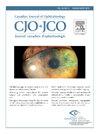Reoperation for congenital ptosis: characteristics, success rates, and predicting factors
IF 3.3
4区 医学
Q1 OPHTHALMOLOGY
Canadian journal of ophthalmology. Journal canadien d'ophtalmologie
Pub Date : 2024-08-03
DOI:10.1016/j.jcjo.2024.06.015
引用次数: 0
Abstract
Objective
Reoperation for congenital ptosis has added morbidity. The purpose of the current study was to examine the risk for redo ptosis surgery in patients with congenital ptosis, as well as to find predictive factors for reoperation.
Methods
This is a retrospective, cohort study. Analysis of all patients with congenital ptosis who underwent their first ptosis correction surgery between 2012 and 2021 at Sheba Medical Center was performed.
Results
Sixty patients (36 male and 24 female) underwent ptosis surgery for congenital ptosis Twenty nine patients (48.33%) underwent frontalis sling (FS), 13 patients (21.67%) underwent levator muscle (LM) surgeries, 9 patients received levator resection (LR), 4 patients received external levator advancement (LAA), and 18 patients (30%) underwent Müller's muscle-conjunctival resection (MMCR). Eighteen patients (30%) underwent a second ptosis surgery. The unadjusted risk of second ptosis surgery was almost four-fold among males with ptosis relative to females with ptosis (HR, 3.90; 95% CI, 3.67-547; p = 0.033) and higher among younger individuals (HR, 4.23; 95% CI, 3.33-5.62; p = 0.042). Older age was protective against the risk of second ptosis surgery (adjusted OR, 0.50; 95% CI, 0.21-0.60; p < 0.001), whereas male sex was associated with an increased likelihood of second ptosis surgery (adjusted OR, 3.33; 95% CI, 1.64-3.98; p < 0.001).
Conclusions
An increased risk of failure of the first surgery was found among male patients, younger patients, and patients with more severe ptosis before the first surgery. Awareness of those factors is beneficial for clinicians and parents.
Objectif
Les reprises de la correction chirurgicale du ptosis congénital aggravent la morbidité. Cette étude visait à examiner le risque de devoir réopérer un ptosis chez les sujets présentant un ptosis congénital, ainsi qu’à cerner les facteurs de prédiction d'une reprise chirurgicale.
Méthodes
Lors de cette étude de cohorte rétrospective, on a réalisé une analyse de tous les patients qui ont subi une première correction chirurgicale du ptosis congénital entre 2012 et 2021 au Sheba Medical Center.
Résultats
Ainsi, 60 patients (36 hommes et 24 femmes) ont subi une correction chirurgicale du ptosis congénital : suspension du releveur au muscle frontal chez 29 patients (48,33 %); chirurgie du releveur chez 13 patients (21,67 %); résection du releveur chez 9 patients; avancement du releveur externe chez 4 patients et résection du muscle de Müller chez 18 patients (30 %). De ce nombre, 18 patients (30 %) ont dû subir une seconde chirurgie pour traiter le ptosis. Le risque non ajusté de reprise de la correction chirurgicale du ptosis était presque 4 fois plus élevé chez les hommes, comparativement aux femmes (rapport de risque [RC] : 3,90; intervalle de confiance [IC] à 95 % : 3,67-5,47; p = 0,033) et plus élevé chez les sujets plus jeunes (RC : 4,23; IC à 95 % : 3,33-5,62; p = 0,042). Un âge plus avancé avait un effet protecteur sur le risque de reprise de la correction chirurgicale du ptosis congénital (rapport de cotes ajusté [RCa] : 0,50; IC à 95 % : 0,21-0,60; p < 0,001), tandis que le sexe masculin était associé à une augmentation du risque de reprise chirurgicale (RCa : 3,33; IC à 95 % : 1,64-3,98; p < 0,001).
Conclusions
On a noté une hausse du risque d’échec de la première chirurgie chez les hommes, les patients plus jeunes et les patients dont le ptosis était plus prononcé avant la première intervention. Il serait utile que les médecins et les parents soient avisés de ces facteurs.
先天性上睑下垂再手术:特点、成功率和预测因素。
背景:先天性上睑下垂再次手术会增加发病率。本研究旨在探讨先天性上睑下垂患者再次进行上睑下垂手术的风险,并找出再次手术的预测因素:这是一项回顾性队列研究。方法:这是一项回顾性队列研究,分析了2012年至2021年间在舍巴医疗中心接受首次上睑下垂矫正手术的所有先天性上睑下垂患者:60 名患者(36 名男性和 24 名女性)接受了先天性上睑下垂手术 29 名患者(48.33%)接受了额肌吊带术(FS),13 名患者(21.67%)接受了提上睑肌手术(LM),9 名患者接受了提上睑肌切除术(LR),4 名患者接受了提上睑肌外提术(LAA),18 名患者(30%)接受了缪勒肌-结膜切除术(MMCR)。18名患者(30%)接受了第二次上睑下垂手术。未经调整的二次上睑下垂手术风险在男性上睑下垂患者中几乎是女性上睑下垂患者的四倍(HR,3.90;95% CI,3.67-547;p = 0.033),在年轻人中则更高(HR,4.23;95% CI,3.33-5.62;p = 0.042)。年龄越大,第二次眼睑下垂手术的风险越低(调整后OR值为0.50;95% CI为0.21-0.60;p < 0.001),而男性与第二次眼睑下垂手术的可能性增加有关(调整后OR值为3.33;95% CI为1.64-3.98;p < 0.001):男性患者、年轻患者和第一次手术前上睑下垂较严重的患者第一次手术失败的风险增加。认识到这些因素对临床医生和家长都有好处。
本文章由计算机程序翻译,如有差异,请以英文原文为准。
求助全文
约1分钟内获得全文
求助全文
来源期刊
CiteScore
3.20
自引率
4.80%
发文量
223
审稿时长
38 days
期刊介绍:
Official journal of the Canadian Ophthalmological Society.
The Canadian Journal of Ophthalmology (CJO) is the official journal of the Canadian Ophthalmological Society and is committed to timely publication of original, peer-reviewed ophthalmology and vision science articles.

 求助内容:
求助内容: 应助结果提醒方式:
应助结果提醒方式:


